The Role of Urban Planning and Design in Building Safe Communities
How can architects and urban planners work with grassroots activists to make neighborhoods safer?
That was one of the topics of a deep and wide-ranging conversation on August 27 between several Chicago Peace Fellows, Mallory McClaire, chief of staff of the Rebuild Foundation, and Gia Biagi, principal of urbanism and civic impact at famed architectural office Studio Gang.
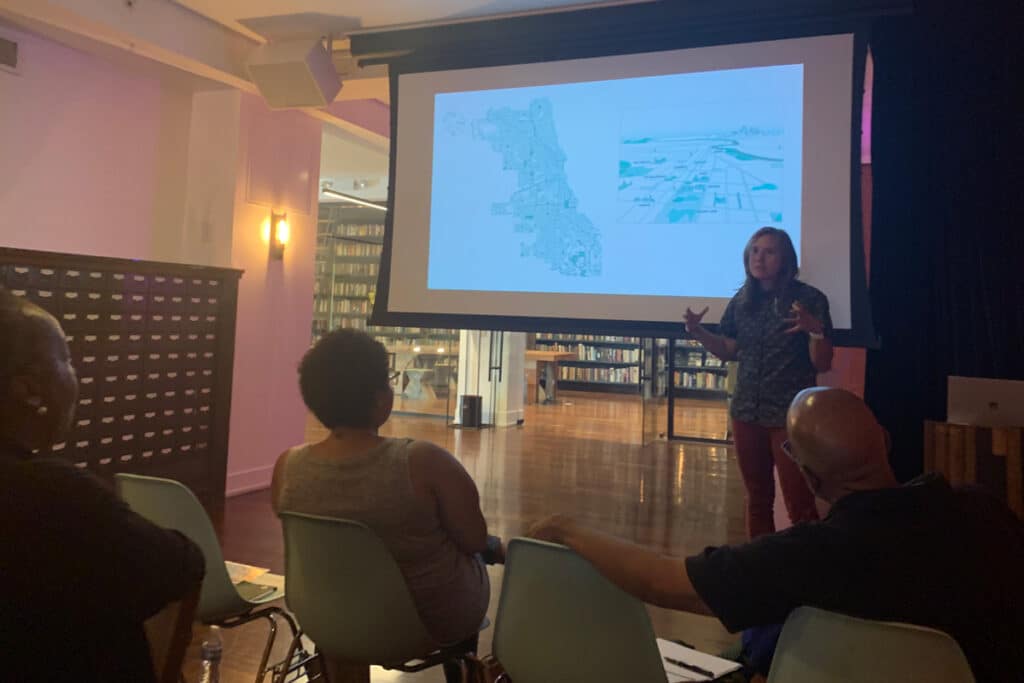
The discussion took place at the Stony Island Arts Bank, a historic financial institution on a main boulevard in the Grand Crossing neighborhood on the South Side that had fallen into disrepair, but was rehabbed into a gallery space, archives and community art center.
While the Fellows ate lunch, Gia began the meeting with a presentation of several projects she and her team had completed in which they explored the assets that community anchors and public spaces can become when cities and citizens invest in collective urban life. She reviewed two projects, Reimagining the Civic Commons and the Mayor’s Office of Criminal Justice: Neighborhood Activation Study in New York, both of which look at civic assets like parks, libraries, and schools as more than physical spaces, but as opportunities for social transformation and inclusion.
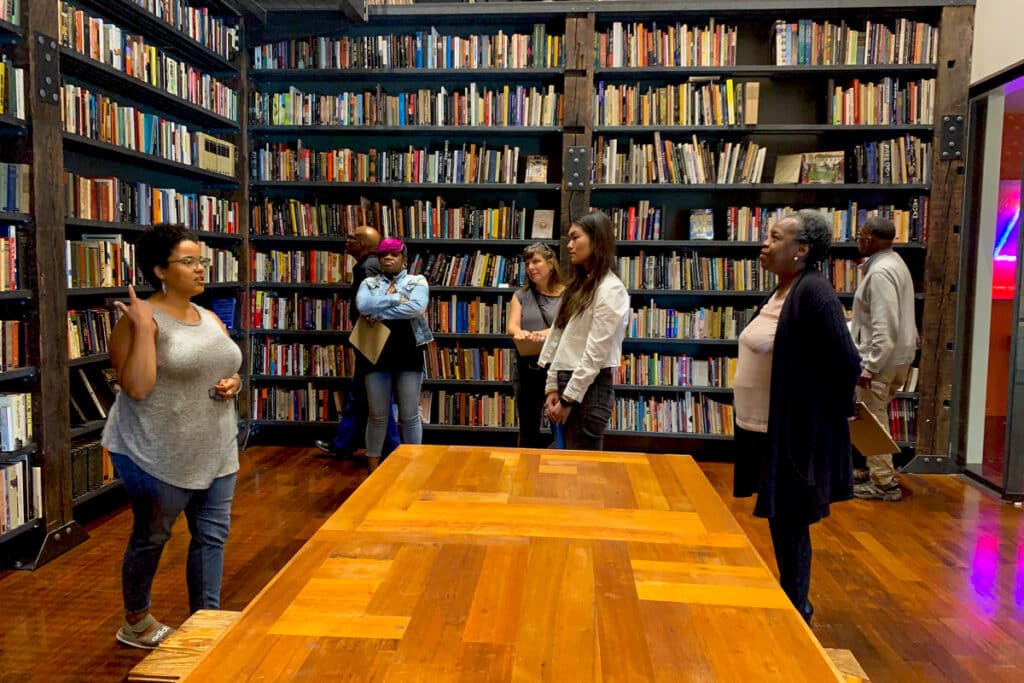
Mallory gave an overview of the Rebuild Foundation, a platform for art, cultural development, and neighborhood transformation. Founded by Chicago-born artist Theaster Gates, their projects seek to strengthen communities by offering free arts programming, creating cultural amenities within the neighborhood, and developing affordable housing and work/studio space for local residents.
The Rebuild Foundation’s work is informed by three core values - Black people matter, Black spaces matter, and Black objects matter. -- Mallory McClaire
The Rebuild Foundation recently hired Studio Gang’s Urbanism and Civic Impact team to create a strategic plan to leverage the properties they own to collectively improve the lives and livelihoods of the neighborhood residents.
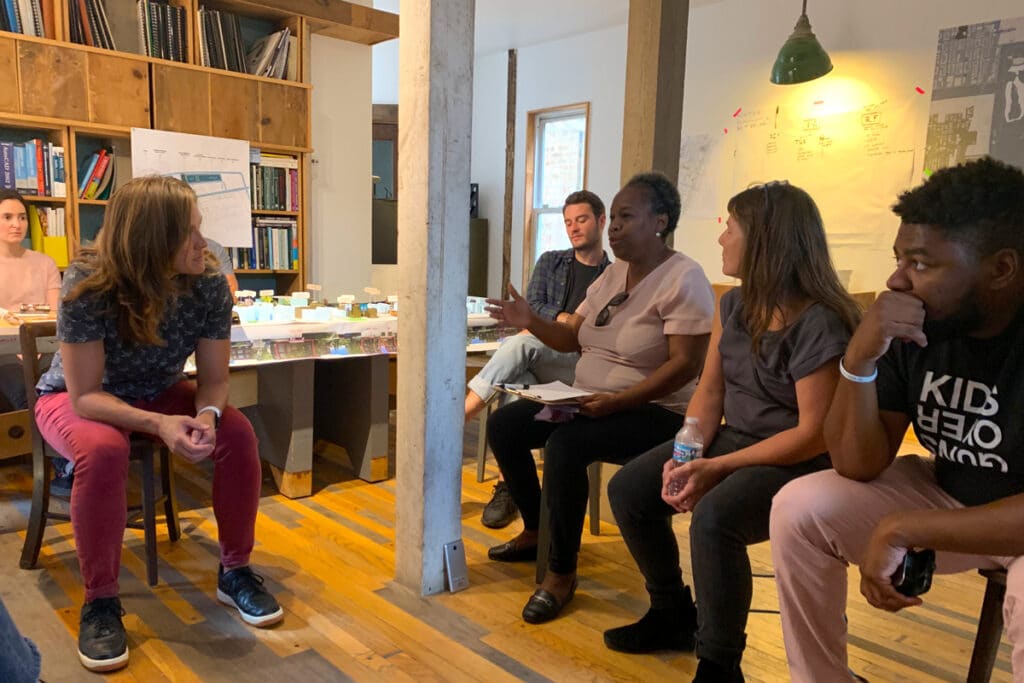
After these presentations, Mallory led the Fellows on a tour of the Stony Island Arts Bank, where they sat in the original leather chairs preserved from the office of Ebony/Jet Founder and Publisher John H. Johnson, reviewed the enormous Johnson Publishing Book Archive, and admired legendary DJ Frankie Knuckles’ record collection. Mallory took the Fellows to a special room where a collection of racist memorabilia and propaganda had been collected and tucked away in drawers, to be reviewed only during facilitated discussions. Fellows compared this alternative display technique with the Field Museum’s Sculptures of Mankind exhibit they viewed and discussed with staff at that institution recently.

The Peace Fellows solemnly visited the exhibit Objects of Care: Material Memorial for Tamir Rice, the gazebo in which the 12-year-old Tamir Rice was playing when he was shot to death by a Cleveland police officer in 2014. Having fought against the gazebo’s demolition, Samaria Rice, Tamir’s mother, requested that the Rebuild Foundation preserve it as a space for community care, dialogue, and public engagement.
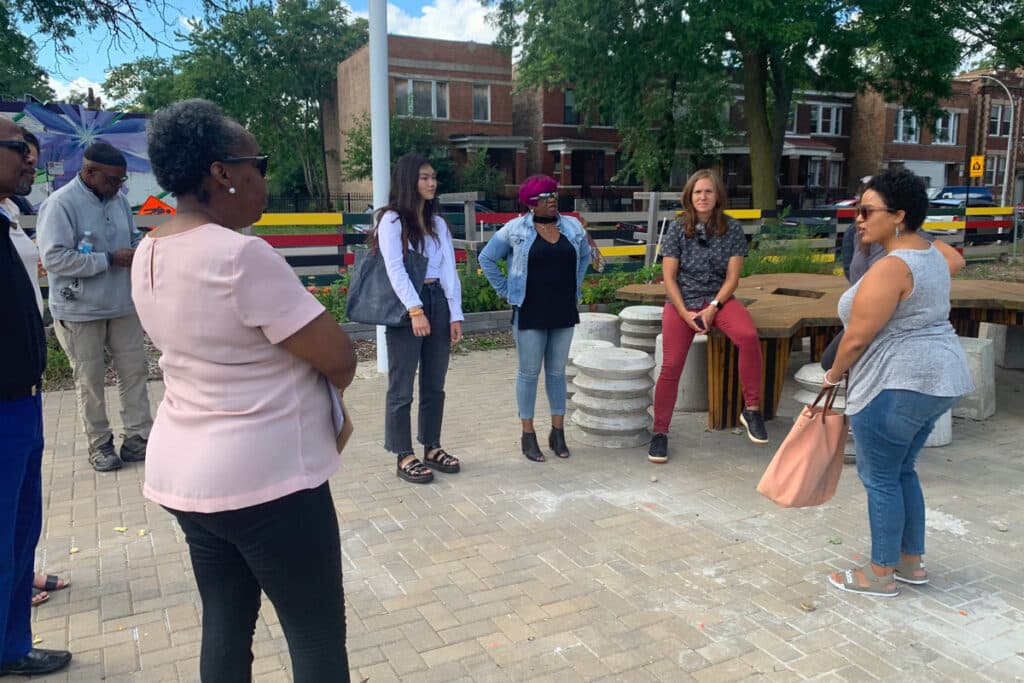
Mallory and Gia then took the Fellows on a tour through the neighborhood, stopping at the buildings renovated and owned by the Rebuild Foundation. The first stop was the Dorchester Community Garden, a public garden space created in partnership with the Rebuild Foundation and NeighborSpace. As children ran through the raised planters and climbed on the built structures, Peace Fellow Robin Cline, assistant director at NeighborSpace, talked about the history and creation of the garden and the impact it has had on the neighborhood.
“A successful space depends so much on the eyes on the space and the commitment to welcome people to sit in these public spaces. We’re going to program the spaces, make the spaces have meaningful activity, and we’re OK with people using the space the way they might want to use it.” -- Robin Cline
The group then gathered around snacks and beverages at Rebuild’s “Listening House” and toured the on-site workspace Studio Gang set up. They also reviewed a model of an asset map of Rebuild and the surrounding neighborhood. Amidst precedent images, working models, and sketches, the group discussed the potential to use the tools and insights of urban planning and civic design to create impact through the built environment and how it could influence their own work.
Fellow Sokoni Karanja talked about the grassroots peace-building efforts in his neighborhood near Washington Park. He relayed to the group how organizing Saturday street cleanings, organizing tenant unions and block clubs, creating several community phone trees, and getting commitments from local citizens and business owners recently helped reduce violence in his neighborhood from 27 homicides in 2016 to 2 so far this year.
“I think violence prevention may be the ultimate goal of our initiative, but really what we want is community cohesion and developing norms of what the community will and will not tolerate. That’s really where the impact will come from. Violence prevention stems out from that.” -- Sokoni Karanja
Mallory spoke about Rebuild’s history as an organization built by an individual’s desire to invest in his own community. Theaster Gates grew up in Chicago and continues to live in the neighborhood, desiring to be an example of what it means to invest in your community. Rebuild has found that their neighbors want transparency as well as a pathway to engagement.

Fellow Jackie Moore said that invitation was all the more important because Greater Grand Crossing has a low percentage of home ownership. When she drives up and down streets in her community, some are pristine and others are not, and almost always, the condition of the street has a direct relationship to whether people own their homes.
When I own the land, I don't need to wait for permission. I don’t think it’s from lack of interest, or lack of design. I think it’s from lack of agency. When you own something, you don’t wait for others to take care of it. When you design spaces with the assumption that they will take care of what has been designed for them, you open yourself up to more opportunities.” -- Jackie Moore
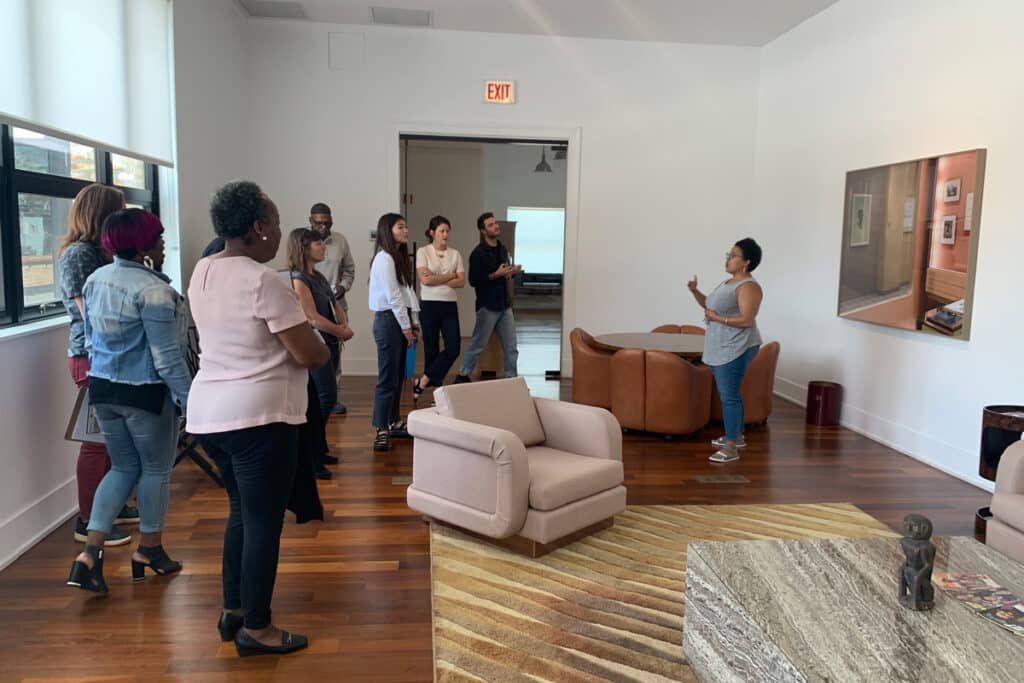
The meeting concluded with a discussion of resources, grants, land trusts and Tax Increment Financing districts - mechanisms that have been set aside for community development - as well as who has figured out how to leverage these resources. The Fellows agreed that urban planners like Gia and her team, and developers and organizations like Rebuild Foundation are potentially good partners for grassroots leaders who are daily making change in their neighborhoods. In addition to well-designed public spaces and informed public policy, planning and design tools can help support the visualization of goals, creation of processes, and leveraging of assets in the work of peace building in our physical environment.
Perspective: The Past and Future of Criminal Justice

In Ferguson, MO, the town where my mother taught when I was a kid, families and neighbors gathered on August 9th to commemorate the third anniversary of the death of Michael Brown, Jr., who was shot and killed by police officer Darren Wilson. In an especially poignant moment, those gathered stood for 4 1/2 minutes of silence, echoing the 4 1/2 hours when Mike Brown's body was left on the street in the summer sun.
The date of August 9th echoed with an eerie and painful coincidence in my current home of New York, as it marks the 20th anniversary of the brutal beating and sodomizing of Abner Louima at the hands of N.Y.P.D. officers while he was in custody at a Brooklyn precinct station house. You can learn more about the case by listening to this recording of my interview with WNYC about the incident and its relevance today.
The coincidence of the anniversaries conjured memories of so many other tragic commemorations. 2017 marked the 26th anniversary of the videotaped beating of Rodney King by L.A.P.D. officers on a California freeway, and 25 years after the riots which ensued there following the acquittal of the four officers charged with his assault.
Police brutality was a hot topic in the conversations after the presentation by Dr. Gaye Johnson at the recent event in Chicago on thebook she co-edited, "Futures of Black Radicalism." At the reception, it was noted that Chicago recently marked the third anniversary of the fateful night in October when LaQuan McDonald was shot 16 times by Chicago Police Department officer Jason Van Dyke.
America has a systemic problem with not shooting its young, black men to death.

While there had been cautious, but notable progress on community policing matters especially since the emergence of the Movement for Black Lives following the killings of Trayvon Martin and Jordan Edwards by Florida civilians, the gradual retrenchment of outmoded strategies is causing great concern from the Goldin Institute hometown of Chicago to cities across the country: New York, Milwaukee, St. Louis, Baltimore, Oakland, Boston Charlotte, Cleveland, and on and on. To be sure, when it comes to policing, the challenges are as tough as they are widespread.
The American Psychological Association released a report in early 2014 — prior to the deaths of Michael Brown, Jr, LaQuan McDonald and 12-year-old Tamir Rice in Cleveland — noting that police officers are more likely to deem the use of force necessary against black youth, more than whites or those from other ethnicities and races. At a younger age than their counterparts, black boys are deemed more accountable for their actions, while whites are given the benefit of the doubt because of their presumed “innocence.”
National statistics bear out the cold ramifications of the study’s conclusions. Last year, of 993 people killed by police, 24% were black, double their representation in American society-at-large. Further, black men are six times as likely to be incarcerated as white men; Hispanic men, meanwhile, are more than twice as likely to be incarcerated as non-Hispanic white men. In total, prisoners of color comprise 67% of the 2.2 million people in America’s prisons and jails.
Since the presidential inauguration in January of this year, a May 2015 executive order signed by President Barack Obama banning local police departments from receiving excess military hardware has been reversed. The original order came about in response to the social unrest in Ferguson seen as having been exacerbated through the use of armored personnel vehicles, military body armor and automatic rifles by local and state police in Missouri.
Additionally, the U.S. Department of Justice made an announcement last September that its COPS (Community Oriented Policing Services) would cease investigating problematic law enforcement agencies and police departments and then issuing reports on alleged misconduct or systemic abuses. “The previous administration was more concerned about the image of law enforcement being too militarized than they were about safety,” opined U.S. Attorney General Jeff Sessions.

Two critical studies done with police departments in Washington, D.C. and New York City, argue against reverting back to the aggressive tactics used to stop crime and violence from the 80’s and 90’s. Last month, the District of Columbia’s police force released findings of an 18-month survey which found that use of excessive force happened at the same rate among officers who were body cameras as those who did not. Additionally, the academic journal “Nature Human Behavior” published findings showing that when N.Y.P.D. officers were curtailed from using “stop and frisk” (by court order) and drew down on making arrests of low level, non-violent, nuisance offenses that major crimes fell throughout the city, a direct refutation of the “broken windows” theory of crime prevention popularized in the 80’s.
These national-level studies only confirm what we already know to be true on the ground: we have a problem with violence and our institutions are part of that problem. I’ve heard countless stories of tensions between police and the communities they serve through a community focused oral history project I have been leading since 2016 in Ferguson. We hope that together these stories can illuminate a way forward, nurture healing conversations and highlight efforts of restorative justice and reconciliation, a model we hope will be useful to other cities in our network.
We also have been hearing similar concerns as we explore these topics with partners in Chicago and around the world. As my colleague Travis Rejman said at a recent meeting with our local partners at Brothers Standing Together, “Our criminal justice system is criminally unjust.” And this isn't limited to our national network. From inhumane prisons in Haiti to religious profiling in the Philippines and East Africa, and the extra stigma faced by demobilized female soldiers in Colombia, criminal justice reform is a shared global concern in our network.
Mirroring the depth and scope of the problem around the world, I also see a deep wealth of knowledge on grassroots collective leadership and strategic wisdom in the global network of the Goldin Institute. I look forward to convening these leaders for shared reflection and action through the Gather Platform that will launch in March 2018. With your support, Gather can become a critical tool in supporting advocates and policymakers to authentically and meaningfully make our communities safer, mitigate police brutality, reduce civilian gun violence and make our criminal justice systems just and equitable.

